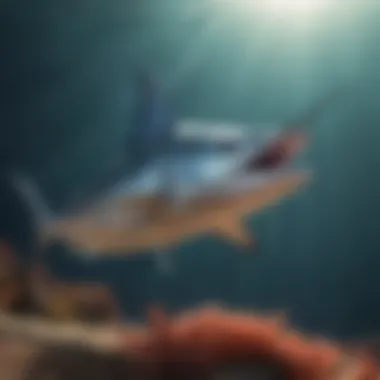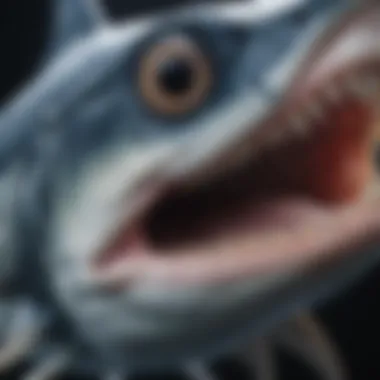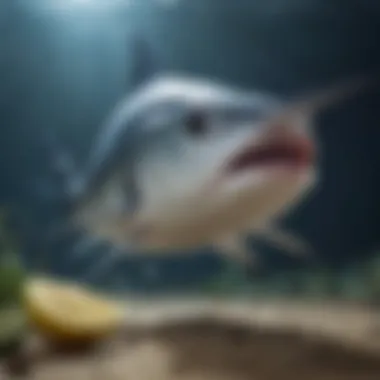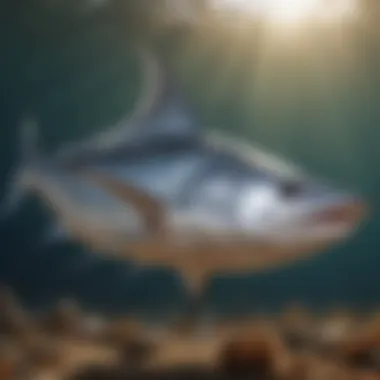Understanding Swordfish Diet: Feeding Habits and Ecology


Intro
The diet of swordfish is a critical aspect in understanding their role as apex predators in marine ecosystems. These fish occupy a unique niche in the ocean, their feeding habits and prey selection act as indicators of the health of their environment. By examining the intricacies of their dietary patterns, we can gain insights into their adaptability and resilience in changing conditions.
Fascinating Facts About the Animal
Swordfish are remarkable creatures with fascinating characteristics that set them apart from other marine life.
Unique Characteristics
Swordfish, scientifically known as Xiphias gladius, can be identified by their notable elongated bills. These bills are not merely for show; they serve a functional purpose. They are used to slash through schools of fish, stunning or injuring prey, making capture easier. Another unique aspect is their ability to reach considerable lengths, sometimes exceeding 11 feet, and an impressive weight of around 1,400 pounds.
Extraordinary Abilities
Swordfish exhibit extraordinary abilities that contribute to their success as predators. They are capable of swimming at high speeds, reaching up to 60 miles per hour. This speed not only aids in hunting but also allows them to evade threats. Furthermore, swordfish can adapt to various temperature ranges in the ocean. Their ability to maintain a higher body temperature than surrounding water enhances their agility and hunting efficiency.
Behavior and Habitat
Understanding swordfish behavior and habitat is essential for grasping their dietary preferences.
Natural Habitats
Swordfish inhabit open ocean waters, primarily in tropical and temperate regions. They are often found at depths ranging from 200 to 1,200 feet. This depth offers them access to a variety of prey, including squid, mackerel, and various fish species. Their migratory behavior is also notable; swordfish travel long distances depending on the time of year, often seeking warmer waters for breeding.
Social Structures
While generally solitary, swordfish can exhibit social behaviors during certain periods, particularly when hunting or migrating together. Understanding these interactions can shed light on their feeding strategies.
Recent Scientific Discoveries
Recent advancements in marine biology have expanded our understanding of swordfish diets and their ecological roles.
Latest Research Findings
Recent studies indicate that swordfish show preferences in prey, often targeting species that are abundant in their habitat. Research has also highlighted changes in their diet due to environmental factors such as rising ocean temperatures and overfishing.
Breakthroughs in Animal Biology
Breakthroughs in animal biology have provided deeper insights into the anatomy and physiology of swordfish. For example, studies on their sensory systems reveal how they detect and capture prey effectively. Understanding these aspects is key to ensuring their conservation and proper management.
Cultural Significance
The swordfish's presence extends beyond ecology into culture and folklore.
Animals in Folklore
In various cultures, swordfish have been depicted in myths and tales, symbolizing strength and navigation through the ocean waters. Their ability to cut through water with speed has made them a subject of fascination.
Influence on Art and Literature
Swordfish have also influenced art and literature, appearing in paintings and literature that celebrate maritime life. These representations contribute to our understanding of their significance not only as predators but as icons of marine narratives.
Understanding the complex relationship between swordfish diets and their environment is essential for effective conservation strategies.
Prelude to Swordfish
Swordfish are remarkable creatures that play a significant role in marine ecosystems. Their large size and unique hunting strategies make them dominant predators in their environment. Understanding swordfish is essential not only from a biological perspective but also for insights into their ecological impact and conservation status.
This section will focus on two key aspects of swordfish: their scientific classification and their physical characteristics. Each contributes to a fuller understanding of this species, which is crucial for those engaged in marine biology, conservation efforts, or simply interested in the richness of oceanic life.
Scientific Classification
Swordfish belong to the family Xiphiidae. Their scientific name is Xiphias gladius. This classification places them in the class Actinopterygii, which includes all ray-finned fishes. The swordfish is closely related to marlins and tunas, highlighting its evolutionary adaptations for a predatory lifestyle. Understanding their classification helps in recognizing their evolutionary biology and ecological relationships.
- Kingdom: Animalia
- Phylum: Chordata
- Class: Actinopterygii
- Order: Perciformes
- Family: Xiphiidae
- Genus: Xiphias
- Species: Xiphias gladius


This classification indicates that swordfish are well adapted to pelagic life, with robust bodies and deep swimming capabilities. They are also anadromous, meaning they migrate for reproductive purposes, an important behavior influencing their population dynamics.
Physical Characteristics
Swordfish are known for their distinctive features which aid in their role as apex predators. They have a long, flat bill resembling a sword, which they use to slash through schools of fish. Adults typically range in length from 2.5 to 4.5 meters and can weigh up to 600 kilograms.
Some notable physical characteristics include:
- Body Shape: Elongated and streamlined, allowing for swift movement.
- Coloration: Dark blue on the dorsal side and silvery on the ventral side, providing camouflage.
- Fins: They have a large dorsal fin that extends along the back, and their pectoral fins are well-developed, aiding in agility.
- Eyes: Large eyes equipped with specialized cells to detect low light, beneficial for hunting in deeper waters.
The unique anatomy of swordfish contributes significantly to their feeding habits and overall behavior. Understanding these traits is vital for comprehending their ecological roles and interactions with other marine species.
Ecological Role of Swordfish
The ecological role of swordfish is substantial, serving as a keystone species in their marine habitats. Their position in the food web highlights the intricate dynamics that exist within ocean ecosystems. Understanding this role provides insights into the overall health of marine environments and the species that inhabit them.
Apex Predator Status
Swordfish are classified as apex predators. This status means they are at the top of the food chain, facing few natural enemies. Their primary competitors include other large pelagic fish such as tuna and marlin. Being an apex predator allows swordfish to regulate prey populations, thus maintaining balance in marine ecosystems.
They possess unique hunting adaptations that make them effective predators. For instance, swordfish have elongated, flat bills that help them slash through schools of smaller fish like mackerel and sardines. Their keen eyesight enables them to locate prey from great distances, especially in deep waters where light is limited. This efficient predation prevents the potential overpopulation of certain species, which can lead to habitat degradation.
Impact on Marine Food Web
The impact of swordfish on the marine food web extends beyond their role as predators. By feeding on various species, they influence the abundance and distribution of those populations. For example, their preference for certain prey types can lead to fluctuations in those species' numbers, affecting other organisms in the web.
Their diet primarily consists of:
- Mackerel
- Sardines
- Squid
Through this predation, swordfish indirectly affect smaller species. When swordfish hunt, they often target the most prevalent species in a particular area. This hunting behavior can lead to shifts in prey dynamics and availability, impacting fish stocks and the livelihoods of humans who rely on them.
The swordfish's position in the marine ecosystem emphasizes the need for conservation efforts. Protecting their populations ensures the stability of the entire food web.
Given their apex predator status and impact on marine food webs, swordfish are crucial for maintaining ecological balance. Environmental changes, like climate change or pollution, could dramatically affect their populations and, consequently, the vitality of marine ecosystems. Understanding these relationships is imperative for effective management and conservation strategies.
Dietary Habits of Swordfish
Dietary habits are crucial for understanding the swordfish's role within its ecosystem. The swordfish, as an apex predator, requires a balanced diet to maintain its health and support its hunting practices. This section delves into their preferred prey and feeding behavior, two key elements that reveal how swordfish interact with their environment and the species that inhabit it.
Preferred Prey
Mackerel
Mackerel is an important part of the swordfish diet. These fish are swift swimmers and are rich in nutrients. They contain high levels of omega-3 fatty acids, making them an ideal food source for swordfish that require a lot of energy. One key characteristic of mackerel is its abundance in both tropical and temperate waters, which makes it readily available for swordfish.
Mackerel's unique feature lies in its speed; this can sometimes be a disadvantage when swimming against the swordfish's lightning-fast strikes. This benefits swordfish as they can easily catch mackerel, providing essential nutrition vital to their survival.
Sardines
Sardines are another significant food source for swordfish. They are small, oily fish that are found in schools, making them a convenient target. Sardines are nutritious, providing energy and essential fats, which is beneficial for swordfish during their hunting efforts.
The unique feature of sardines is their schooling behavior, which can actually work in the swordfish's favor. When sardines swim together, they create a large, cohesive target. This can be advantageous for swordfish but can also lead to overfishing concerns, affecting their availability.
Squid
Squid is also a primary dietary component for swordfish. This cephalopod is a rich source of protein and has a unique ability to change color, which provides it some camouflage against predators. Squid can be found in various ocean depths, which means swordfish must adapt their hunting strategies based on availability.
The unique feature of squid is its capability to move quickly by expelling water, which can create challenges for swordfish. Still, the payoff is worth the effort when swordfish successfully capture squid, gaining valuable nutrients that support their fast-paced lifestyle.
Feeding Behavior
Hunting Techniques
Swordfish utilize a variety of hunting techniques to catch their prey. Their preferred method is ambush, which involves patiently waiting for the right moment to strike. This technique allows them to conserve energy while maximizing their chances of a successful catch. Their elongated, flattened bills are effective tools for slashing at schools of fish and stunning or injuring prey.
A key characteristic of hunting techniques in swordfish is their stealth. They can approach prey without being noticed, increasing their hunting success. However, the reliance on ambush can also mean that they miss opportunities if the prey is not in the right location.


Use of Speed and Agility
The use of speed and agility in swordfish feeding has a profound impact on their hunting success. Swordfish are among the fastest fish in the ocean. Their streamlined bodies enable swift movements that can surprise prey. This ability allows them to cover large distances quickly and to engage in rapid pursuits.
A distinct advantage of speed and agility is that it not only aids in immediate hunting but also helps in escaping from potential threats. However, this lifestyle demands high energy expenditure, which emphasizes the importance of their dietary habits.
Understanding swordfish dietary habits reveals a complex interaction with marine ecosystems, showcasing their role as apex predators and the importance of balancing their diet with environmental changes.
Interactions with Other Species
The interactions that swordfish have with other species is fundamental to understanding their role in marine ecosystems. As apex predators, they exert significant influence over the populations of their prey. These interactions shape not only the swordfish diet but also the dynamics within the marine food web. This section will discuss competition for food and potential threats posed by natural predators and human activities.
Competition for Food
Other Predatory Fish
Other predatory fish are key competitors for food sources within the same marine environments as swordfish. Species such as sharks and tuna share similar dietary preferences, often targeting the same types of prey like mackerel and squid. The competition is significant because it can lead to a decrease in the availability of these resources. For swordfish, this means they must adapt their hunting strategies to secure food.
The key characteristic of these other predatory fish is their size and hunting prowess. Many are faster swimmers, capable of outpacing swordfish in open water. This leads to a natural selection process where swordfish have to be more cunning in their approach, relying on stealth and precise strikes to catch their prey. This dynamic among predators highlights the swordfish's role in maintaining ecological balance.
A unique feature of these predatory fish is their ability to hunt in packs, which can create challenges for swordfish. On the downside for these competitors, they often require larger territories and can be impacted by overfishing, which makes their population numbers fluctuate.
Environmental Adaptations
Environmental adaptations play a crucial role in how swordfish interact with other species. These adaptations can manifest in various forms, from their physical features to their behavior. The ability of swordfish to dive deeply into cooler waters allows them to evade competition during parts of the day that are less favorable for other predators. This behavior contributes positively to their overall survival and feeding success.
One prominent aspect of these adaptations is the swordfish's specialized vision. They possess acute eyesight that allows them to detect prey in low light conditions, such as during dawn or dusk. This adaptation gives them an edge over other species that may rely on different sensory inputs. In this article, looking at these techniques can provide deeper insight into how swordfish secure their diets in a competitive environment.
On the other hand, these adaptations can also create vulnerabilities. Changes in water temperature, for instance, can affect their hunting territories and prey availability.
Predation and Threats
Natural Predators
Natural predators remain a constant threat to swordfish, despite their apex status. While adult swordfish have few predators, young swordfish are at risk of being preyed upon by larger fish species, including blue sharks and bigeye thresher sharks. Understanding these interactions can illuminate the life cycle challenges swordfish face as they grow.
The key characteristic of natural predators is that they are often larger than the juvenile swordfish, which makes them effective hunters. This predation pressure plays a role in population dynamics and can influence spawning behaviors within swordfish populations. Many fish species might target young swordfish due to their vulnerability.
Moreover, recognizing the predators that threaten swordfish can aid in conservation efforts. Focusing on creating protective environments or marine reserves can help replicate safe zones for juvenile swordfish, improving their survival rate.
Human Impact
Human impact on swordfish populations presents one of the largest threats to their survival. Overfishing has dramatically reduced swordfish numbers in many areas. Large-scale fishing methods can lead to bycatch, which not only diminishes swordfish populations but also affects other species caught inadvertently during fishing operations.
The key characteristic of human impact is its widespread nature, affecting not just individual species but entire ecosystems. The complex effects of overfishing can include changes in prey dynamics, traditionally favorable conditions are altered, leading to a decreased availability of resources for swordfish.
A unique feature of this impact is the legislation and sustainable practices that have emerged in response. Efforts to regulate fishing quotas and establish marine protected areas aim to stabilize swordfish populations. These measures serve both as a conservation strategy and a way to maintain a sustainable fishery that can benefit human consumption without compromising the species' future.
Understanding the interaction between swordfish and other species, including both competitors and threats, is essential for effective conservation strategies.
The examination of these interactions emphasizes the importance of considering both environmental and biological factors in conservation efforts and sustainable fishing practice.
Impact of Environmental Changes
The impact of environmental changes on swordfish diets is a significant aspect of understanding their ecology and conservation needs. Both climate change and pollution can alter their habitat and food sources, consequently affecting their dietary habits. Understanding these impacts can help in the development of sustainable fishing practices and conservation strategies.
Climate Change Effects
Temperature Fluctuations
Temperature fluctuations in ocean waters can substantially affect swordfish and their prey. As water temperatures rise due to climate change, swordfish may alter their distribution patterns. Warmer waters can lead to an increased metabolic rate in swordfish, which translates to higher energy demands. This may drive swordfish to hunt more or migrate to cooler areas where prey is available.
A key characteristic of temperature fluctuations is that they create stress within marine ecosystems. When ocean temperatures shift rapidly, it can affect the breeding, spawning, and survival rates of prey species such as mackerel and squid. Higher temperatures may result in reduced oxygen levels, further impacting food availability. Therefore, understanding these temperature dynamics is crucial for predicting swordfish behavior and their overall health.
Prey Availability


Prey availability is critical to the survival of swordfish. Changes in ocean temperature and currents can influence the abundance and distribution of their preferred prey. For instance, as sardines and other forage fish populations migrate or decline, it affects swordfish feeding habits. Often, if prey is lessened, swordfish may face nutritional stress, leading to potential declines in their own population.
The unique feature of prey availability fluctuations is its direct relationship with both the health of marine ecosystems and the swordfish themselves. When certain species become more scarce due to overfishing or environmental changes, it creates competition among predators, including swordfish. Thus, discussing prey availability aligns well with understanding the overall diet and health of swordfish in changing marine environments.
Pollution and its Impacts
Pollution poses significant threats to swordfish diets and their habitat. Chemical pollutants, such as heavy metals and plastics, can accumulate in the bodies of prey species. These toxic substances can then be transferred up the food chain to swordfish, leading to health issues such as impaired immune function and reproductive failures. Furthermore, polluted waters can disrupt the food web, making it harder for swordfish to find suitable prey.
Swordfish Diet and Human Consumption
The examination of swordfish diets extends beyond biological interest. It is also directly linked to human consumption habits and agricultural practices in fisheries. Understanding the dietary patterns of swordfish helps in evaluating sustainability, nutrition, and health concerns associated with human consumption. The importance of this topic lies in its ability to influence fishery practices, guide consumer choices, and provide insights for seafood safety standards.
Sustainability of Swordfish Fishing
The sustainability of swordfish fishing poses significant implications both for ecosystems and for human consumers. Historically, swordfish populations have faced intense fishing pressures. However, there are now regulated practices geared towards ensuring their populations remain stable. Sustainable fishing strategies include:
- Regulatory frameworks: Setting quotas and size limits to prevent overfishing.
- Bycatch reduction: Utilizing gear that minimizes capturing non-target species, preserving other marine life.
- Certification programs: Organizations such as the Marine Stewardship Council (MSC) promote sustainably sourced seafood, allowing consumers to make informed choices.
Consumers increasingly prefer sustainable swordfish options, which encourages fishing industries to adopt environmentally friendly practices. Insisting on sustainably sourced swordfish contributes to maintaining healthy ocean ecosystems.
Nutritional Value of Swordfish
Swordfish offers substantial nutritional benefits, making it a popular choice among seafood lovers. It is rich in essential nutrients such as:
- High-quality protein: Swordfish provides about 20 grams of protein per 100 grams, contributing to muscle synthesis and overall health.
- Omega-3 fatty acids: These beneficial fats are known for their heart health benefits and anti-inflammatory properties.
- Vitamins and minerals: Swordfish is a good source of vitamin D, vitamin B12, selenium, and niacin, all crucial for various bodily functions.
However, it is essential to navigate potential health concerns, particularly related to mercury levels and environmental factors that can influence swordfish nutrition. Consumers should consider these aspects, especially when pregnant or nursing, to safeguard their health while still enjoying seafood as part of a balanced diet.
Informed decisions about swordfish consumption contribute to the health of both individuals and marine ecosystems.
Conservation Efforts
Conservation efforts are essential for the sustainability of swordfish populations and their marine habitat. As apex predators, swordfish play a crucial role in maintaining the balance of marine ecosystems. These efforts help mitigate threats to their populations, ensuring their survival for future generations while contributing to the overall health of the oceans.
Current Conservation Strategies
Regulated Fishing Practices
Regulated fishing practices provide a framework to manage swordfish populations effectively. These rules typically involve catch limits, size restrictions, and seasonal closures. The key characteristic of regulated fishing practices is their aim to prevent overfishing. This is beneficial for swordfish stocks and marine biodiversity as a whole.
A unique feature of these practices is the establishment of quotas based on scientific assessments of fish populations. This data-driven approach allows for adaptive management; adjustments can be made as needed to respond to changing ecological conditions. However, a disadvantage is the potential for illegal fishing activities that can undermine these regulations.
Protected Marine Areas
Protected marine areas (PMAs) are designated sections of the ocean where human activities are restricted or managed to safeguard marine life. For swordfish, PMAs offer critical sanctuary from fishing pressure during spawning or migration times. The main characteristic of PMAs is that they create safe havens for various marine species, including swordfish.
The unique feature of PMAs is their ability to foster biodiversity. By providing a refuge, they can enhance fish populations over time, not just for swordfish but for other marine life as well. Nonetheless, the establishment of PMAs may lead to economic trade-offs for local fishing communities, as restrictions might limit their access to traditional fishing grounds.
The Role of Research and Education
Research and education play a pivotal role in the success of conservation efforts for swordfish. Scientific studies gather data on population dynamics, migration patterns, and the overall impact of environmental changes. This information is crucial for making informed decisions about management practices.
Education helps raise awareness among stakeholders, including fishermen, policymakers, and the general public. Understanding the importance of swordfish to marine ecosystems fosters a sense of responsibility in conserving these species and their habitats.
Conservation efforts based on solid research and community engagement empower individuals to make informed choices that positively affect marine life and ecosystems.
Closure
The conclusion serves as a pivotal section in this article, encapsulating the essence of the discussions about swordfish diets. It synthesizes the intricate relationship between swordfish and their marine environment, emphasizing their role as apex predators and the implications of their dietary habits on broader ecological systems. Understanding these dynamics is essential for appreciating the entire marine ecosystem's health.
Summary of Key Points
In reviewing the key concepts covered in this article:
- Dietary Composition: Swordfish primarily prey on species such as mackerel, sardines, and squid due to their nutritional importance and abundance in their habitats.
- Feeding Strategies: Their unique hunting techniques, characterized by speed and agility, allow them to efficiently locate and capture prey in the open ocean.
- Ecological Impact: As apex predators, swordfish influence the population dynamics of their prey, maintaining ecological balance within marine environments.
- Environmental Factors: Factors like climate change and pollution pose significant threats to their feeding patterns and availability of prey, highlighting the need for careful monitoring.
- Conservation Initiatives: Current conservation strategies and the role of research are crucial in ensuring the sustainability of swordfish populations.
Future Directions in Research
Future research should focus on several areas to enhance our understanding of swordfish dietary habits:
- Environmental Adaptability: Investigate how swordfish adapt their diets in response to changing oceanic conditions due to climate events.
- Prey Dynamics: Study the relationships between swordfish and their prey species, especially in light of overfishing and habitat degradation.
- Mapping Migration Patterns: Understanding the migratory habits of swordfish could provide insights into their feeding strategies and how they interact with changing environmental factors.
- Technological Integration: Utilize new technologies like drone surveillance and ecological modeling to track swordfish behavior and prey availability comprehensively.
Continuing this research can lead to better conservation practices, ensuring the survival of swordfish and the health of marine ecosystems.







